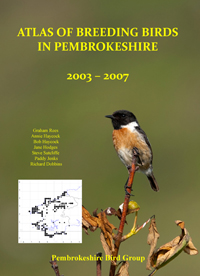Breeding summer visitor. Not recorded in January and February.
Storm Petrels are difficult birds to survey, since they nest in crevices, often on inaccessible scree slopes. However, 6,000 pairs were estimated as breeding at Skokholm in 1969. A survey carried out at Skokholm using a light amplifier, conducted in 1990, resulted in a distribution of colonies little changed from that of a 1967 survey. Recent work at Skomer suggests probably less than 200 pairs breed on that island. Three nests were found on North Bishop in 1985 but it was suspected that there were more. Breeding birds were established on the Green Scar in 1928 and 1930, were probably breeding on Middleholm and have been seen in suitable terrain at St Margaret's Island and on Stack Rocks in St Bride's Bay in the past. It is possible they nest in scree at the foot of some mainland cliffs where they have been seen leaving crevices in the breeding season.
The imprecision of census results obstructs the detection of population trends. There are no mammalian predators at their known nesting localities but they are predated by gulls, by Little Owls at Skomer and formerly at Skokholm, and they occasionally die from other, sometimes bizarre, causes; for instance, a bird died when it became ensnared in the seed head of lesser burdock at Skokholm.
Much of what is known of the breeding cycle of the Storm Petrel is derived from work carried out at Skokholm, first by Lockley (1932), followed by Davis (1957) and Scott, who was resident from 1966 to 1969 (Scott 1970). They arrive in home waters in April, occasionally in March, and most depart by October. Autumnal gales, particularly in early September, can blow considerable numbers inshore; for example, over 100 were seen at Strumble Head on 3 September 1983. Extensive mist netting and ringing at headlands indicates a strong, regular through passage of non-breeding birds late in the breeding season. The breeding population appears to use the Irish Sea only sparingly as a feeding area, but regularly frequents the Bristol Channel and, even more so, the southern Celtic Deep.

Fieldwork 1984-88
Red = breeding confirmed = 3
Total tetrads in which registered = 3
Donovan J.W. & Rees G.H (1994), Birds of Pembrokeshire
 Sunday, September 15, 2013 at 9:09AM
Sunday, September 15, 2013 at 9:09AM  1949 BoP in
1949 BoP in  Storm Petrel
Storm Petrel 




